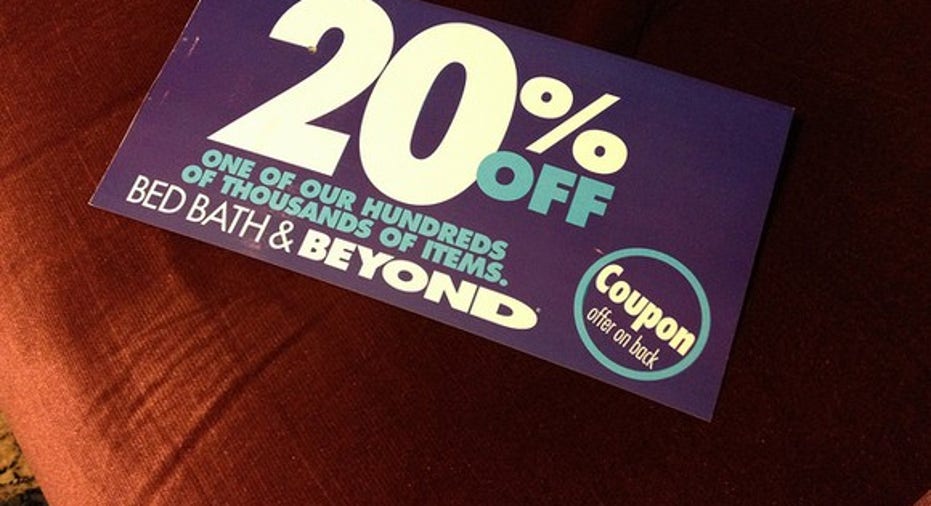Bed Bath & Beyond's 20% Off Coupons Didn't Disappear, They Just Cost $29 Now

Home goods retailer Bed Bath & Beyond thinks it can get customers to pay for the discounts they previously got for free, but it may not be quite as simple as the company believes. Image source: The Motley Fool.
On the surface, Bed Bath & Beyond's (NASDAQ: BBBY) new member loyalty program looks like a smart way to wean itself off those ubiquitous blue-and-white coupons that flood your mailbox seemingly every week. Instead of everyone getting 20% off on a single item, only loyalty club members would receive them, along with a few other perks, and it would cost $29 a year, a nice new revenue stream for the home goods retailer.
After another disappointing quarter, Wall Street has praised Bed Bath & Beyond's plan. Net sales came in below $3 billion, largely unchanged from last year, but comparable-store sales were down 1.2% -- and it's the second straight quarter they were down, also by a much wider decline than the 0.5% drop in the first period.
CEO Steve Temares said the retailer's couponing efforts have been successful over the years, and the discount flyers are part of Bed Bath & Beyond's identity, "But really, we need to be working -- and we are working -- on becoming a lot more intelligent about our marketing and making it much more personalized."
Don't discount the risks
That, and the fact that the coupons continue to eat away at margins, are likely what spurred the retailer to make the change.
It's not an unheard-of practice. Amazon.com (NASDAQ: AMZN) has blazed the path in rewarding loyal customers with perks such as free shipping (among other benefits) through its Prime program and charging for membership,but there are some key differences between what Bed Bath & Beyond wants to do and what the e-commerce leader has done that make the home goods retailer's plan dicey.
Here are four reasons why the new Beyond+ loyalty program might not be as successful as Prime.
- Customer habits are hard to change.
- Discounting isn't being eliminated, just displaced.
- Free shipping raises costs.
- The program is cheap.
Teaching old dogs new tricks
As Temares says, the 20% off coupon is part of Bed Bath & Beyond's DNA, so much so that customers largely won't shop at the store unless they have one or more coupons in hand. Although that's undermining profits, and margins fell across the board last quarter, getting consumers to change their shopping habits isn't an easy task.
When J.C. Penney (NYSE: JCP) sought to reimagine itself as a modern-day department store offering everyday low pricing instead of "fake" prices that supported planned sales, customers fled and almost bankrupted the retailer even though they would've been paying less money on a regular basis. Bed Bath & Beyond risks alienating its customer base by requiring them to pay $29 for a benefit they previously got for free.
Paying for the privilege
As noted, the retailer isn't getting rid of the problem that has plagued it, but rather shuffling it around and having people pay to get it. While that does provide Bed Bath & Beyond with a stream of revenue that could offset the costs of the discounting, the retailer is still stuck with having to markdown potential profits, and it's applying the 20% off on both in-store and online purchases.
Increasing costs
By providing free shipping for all orders placed by loyalty program members, Bed Bath & Beyond will increase its costs. Yet as noted above, shoppers are also getting a discount on their purchases, so they're doubly benefiting while the retailer is eating the costs, only modestly offset by the $29 membership fee. That could pinch margins.
Underpricing the value
At just $29 a year, Bed Bath & Beyond is pricing the program in keeping with the discount image, but it could just be too cheap for all the value it's giving customers. While that could be an enticement to get them to accept losing the previous barrage of free coupons, it still amounts to giving away the store.
The retailer might not be able to price it the same as Amazon did when it launched Prime at $79 a year, but it still seems low. Perhaps Bed Bath & Beyond is thinking it will be able to raise the cost afterwards just like Amazon did when it increased the Prime annual fee to $99, but the e-commerce king's members get a lot of value for their money: In addition to free shipping, they get free music, free movies, and most recently free e-books. The home goods store doesn't have anything comparable and raising the price later might not be so easy.
In short, Bed Bath & Beyond does need to move away from couponing, but simply charging customers $29 for the privilege, expanding it to cover both in-store and online purchases, and increasing its own costs at the same time with free shipping seems like a disaster waiting to happen.
A secret billion-dollar stock opportunity The world's biggest tech company forgot to show you something, but a few Wall Street analysts and the Fool didn't miss a beat: There's a small company that's powering their brand-new gadgets and the coming revolution in technology. And we think its stock price has nearly unlimited room to run for early in-the-know investors! To be one of them, just click here.
Rich Duprey has no position in any stocks mentioned. The Motley Fool owns shares of and recommends Amazon.com. The Motley Fool recommends Bed Bath and Beyond. Try any of our Foolish newsletter services free for 30 days. We Fools may not all hold the same opinions, but we all believe that considering a diverse range of insights makes us better investors. The Motley Fool has a disclosure policy.



















